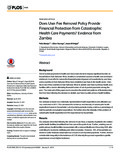| dc.description.abstract | Out-of-pocket payments in health care have been shown to impose significant burden on households in Sub-Saharan Africa, leading to constrained access to health care and impoverishment. In an effort to reduce the financial burden imposed on households by user fees, some countries in Sub-Saharan Africa have abolished user fees in the health sector. Zambia is one of few countries in Sub-Saharan Africa to abolish user fees in primary health care facilities with a view to alleviating financial burden of out-of-pocket payments among the poor. The main aim of this paper was to examine the extent and patterns of financial protection from fees following the decision to abolish user fees in public primary health facilities.Our analysis is based on a nationally representative health expenditure and utilization surveyconducted in 2014. We calculated the incidence and intensity of catastrophic healthexpenditure based on households’ out-of-pocket payments during a visit as a percentage of total household consumption expenditure. We further show the intensity of the problem of
catastrophic health expenditure (CHE) experienced by households. Our analysis show that following the removal of user fees, a majority of patients who visited public health facilities benefitted from free care at the point of use. Further, seeking care at public primary health facilities is associated with a reduced likelihood of incurring CHE after controlling for economic wellbeing and other covariates. However, 10% of households are shown to suffer financial catastrophe as a result of out-of-pocket payments. Further, there is considerable inequality in the incidence of CHE whereby the poorest expenditure quintile experienced a much higher incidenceDespite the removal of user fees at primary health care level, CHE is high among the poorest sections of the population. This study also shows that cost of transportation is mainly responsible for limiting the protective effectiveness of user fee removal on CHE among particularly poorest households | en_US |

